
Browse an alphabetical list of photographs. These historical images portray people, places, and events before, during, and after World War II and the Holocaust.
<< Previous | Displaying results 1551-1600 of 2641 for "Photo" | Next >>
Martin Niemöller, a German theologian and pastor, on a visit to the United States after the war. A leader of the anti-Nazi Confessing Church, he spent the last seven years of Nazi rule in concentration camps. United States, October 4, 1946.
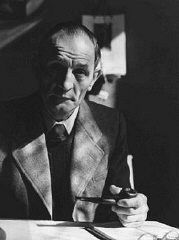
Marzahn, the first internment camp for Roma (Gypsies) in the Third Reich. Germany, date uncertain.

Site where members of Einsatzgruppe A and Estonian collaborators carried out a mass execution of Jews in September 1941. Kalevi-Liiva, Estonia, after September 1944.
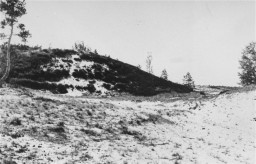
Site where members of Einsatzgruppe A and Estonian collaborators carried out a mass execution of Jews in September 1941. Kalevi-Liiva, Estonia, after September 1944.
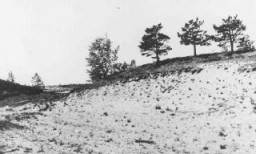
A mass grave at Bergen-Belsen soon after the liberation of the camp. Bergen-Belsen, Germany, May 1945.
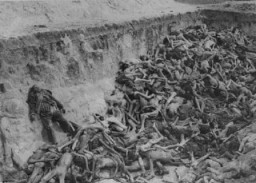
After camp liberation, one of the mass graves at the Bergen-Belsen camp. Germany, after April 15, 1945.
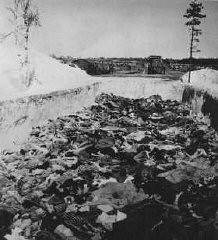
A mass grave at the Mauthausen concentration camp. Photograph taken after the liberation of the camp. Mauthausen, Austria, May 10–15, 1945.
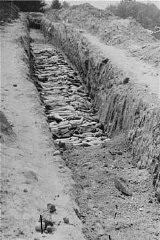
American soldiers walk along an open mass grave for the of victims of the Nordhausen concentration camp. US army officers ordered the residents of Nordhauen to prepare the grave for the burial of the victims. Nordhausen, Germany, April 13–14, 1945.
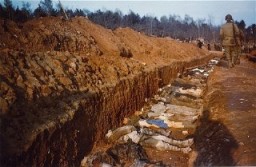
A mass grave dug by Jewish forced laborers for the bodies of individuals murdered by the NKVD in Lvov prisons. The NKVD (Soviet secret police) murdered thousands of Ukrainian nationalists, as well as some Jews and Poles, before retreating from the Nazi invasion. The Germans and their Ukrainian collaborators then used the massacre as a pretext for anti-Jewish pogroms, claiming that the Jews had helped the secret police. Lvov, Poland, July 3, 1941.
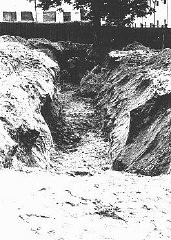
A mass marriage of 50 couples in Berlin. All of the couples belonged to the Nazi Party. Berlin, Germany, July 2, 1933.
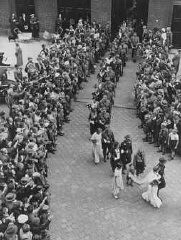
US troops inspect a barn on the outskirts of the town of Gardelegen that was the site of the massacre of over 1,000 concentration camp prisoners. Germany, April 14-18, 1945.

Spectators in the stands of the Zeppelinfeld look on as Adolf Hitler's car moves towards the speakers' platform at the opening of Reichsparteitag (Reich Party Day) ceremonies in Nuremberg. The Zeppelinfeld was part of the Nazi Party rally grounds. Nuremberg, Germany, September 1935.
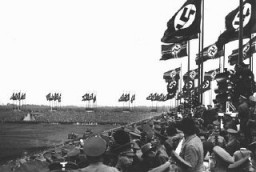
Emaciated survivors in barracks in the Mauthausen camp. Austria, May 1945, after liberation.
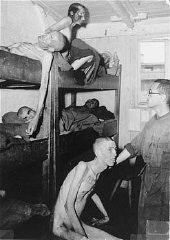
Mauthausen concentration camp inmates with American troops after the liberation of the camp.
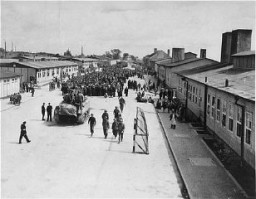
A view of the quarry at the Mauthausen concentration camp, where prisoners were subjected to forced labor. Austria, 1938-1945.

A US soldier looks at the Mauthausen crematorium during the liberation of the camp. Austria, May 1945.
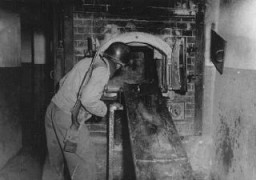
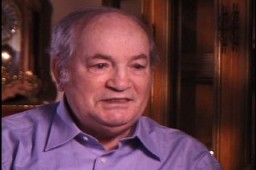
A Maypole topped with a swastika is raised for a May Day parade in the Lustgarten in Berlin. The May holiday became an important celebration in the Nazi calendar. Germany, April 26, 1939.
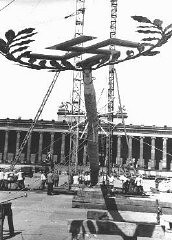
A prisoner in a compression chamber loses consciousness before dying during a medical experiment simulating high altitudes. Dachau Concentration Camp, Germany, 1942.
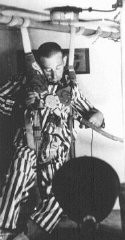
Medical experiment performed at the Dachau concentration camp to determine altitudes at which German pilots could survive. Germany, 1942.
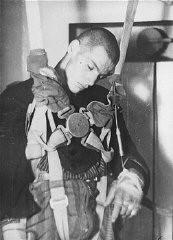
Meeting of the War Refugee Board in the office of Executive Director John Pehle. Pictured left to right are Albert Abrahamson, Assistant Secretary of the Treasury Josiah Dubois, and Pehle. Washington, DC, United States, March 21, 1944.
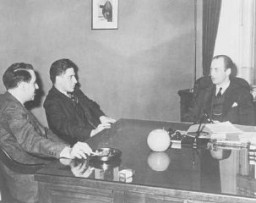
An African American soldier is among those members of the Soviet and US armed forces posing here upon the historic meeting of the two armies on the Elbe River. Torgau, Germany, April 26, 1945.
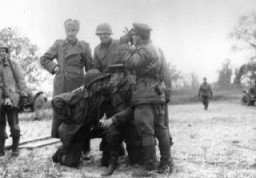
A Hitler Youth poses for a photograph in the Rhineland city of Bruehl, 1934. The Hitler Youth and the League of German Girls were the primary tools that the Nazis used to shape the beliefs, thinking and actions of German youth.
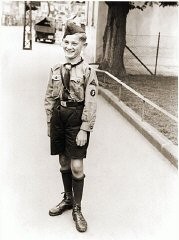
Photograph taken by George Kadish: a member of the Kovno ghetto underground hides supplies in a well used as the entrance to a hiding place in the ghetto. Kovno, Lithuania, 1942.
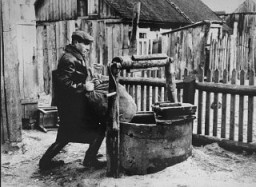
Group portrait of members of the Hashomer Hatzair socialist Zionist youth movement. Pictured in the back row, left to right, are: Tzvi Braun, Shifra Sokolka and Mordechai Anielewicz. Seated in front are Moshe Domb and Rachel Zilberberg ("Sarenka"). Warsaw, Poland, 1938.
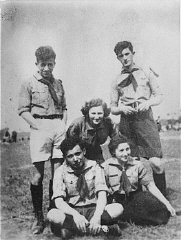
Blanka's daughter Shelly, son-in-law, and granddaughter Alexis Danielle on a vacation.

Members of the Bielski partisan group at the site of a mass grave shortly after liberation. Poland, 1945.
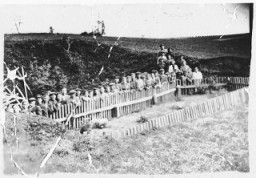
Prewar family portrait of members of the Danishevska family in Vilna, Lithuania, 1926–27. None of those pictured here survived the Holocaust.
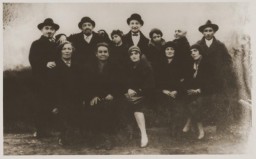
Members of the German Africa Show (Deutsche Afrika-Schau), circa 1937 in Germany. Though these early shows were exploitative by nature, artists originally had the ability to shape their own performances and how they were represented. After the Nazis came to power in 1933, this agency began to disappear. During the Nazi era, working in such shows was an increasingly propaganda-driven, demoralizing, and unpleasant experience. Known persons in the photograph from left to right: Josef Boholle is the furthest…
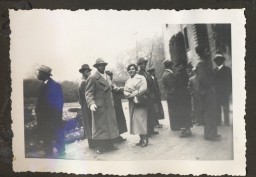
The French prosecution table at the International Military Tribunal trial of war criminals at Nuremberg.
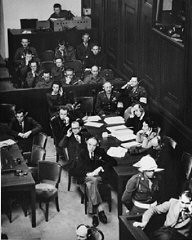
Members of the Hitler Youth march before their leader, Baldur von Schirach (at right, saluting), and other Nazi officials including Julius Streicher. Nuremberg, Germany, 1933.
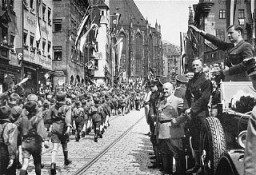
Members of the Hlinka Guard and a squad of ethnic Germans march during a parade in Slovakia, a Nazi satellite state. Date uncertain.
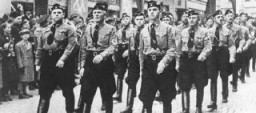
Soldiers and vehicles of the Jewish Brigade Group, which participated in the final Allied offensive in Italy. Italy, March 24, 1945.
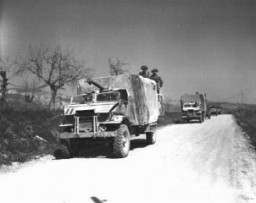
A parade of young Austrian women, members of the Nazi youth organization the League of German Girls (Bund Deutscher Maedel). Graz, Austria, February 20, 1938. The Hitler Youth and the League of German Girls were the primary tools that the Nazis used to shape the beliefs, thinking and actions of German youth.
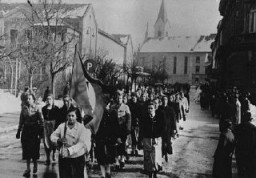
Members of the paramilitary organization of the Dutch Nazi Party stand in the doorway of a restaurant. The sign states "Jews are not desired." Amsterdam, the Netherlands, 1941–42.
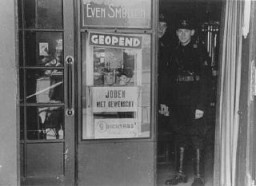
SA men in front of Jewish-owned store urge a boycott with the signs reading "Germans! Defend Yourselves! Don't buy from Jews!" Berlin, Germany, April 1, 1933.
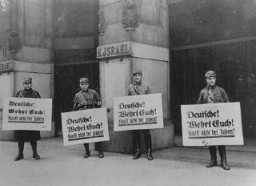
Members of the SS (Schutzstaffel; originally Hitler's bodyguard, later the elite guard of the Nazi state) parade during a rally. Germany, date uncertain.
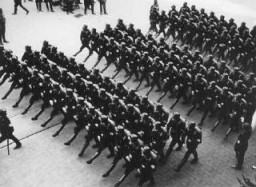
Polish Jewish refugee children known as the "Tehran Children" gather at a memorial stone dedicated to the Jewish refugees who died when the Patria (a ship bound for Palestine) sank in November 1940. Atlit, Palestine, 1943.
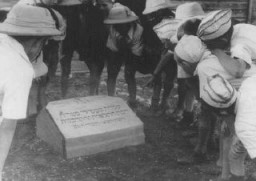
Members of the US Olympic team—runners Helen Stephens and Jesse Owens—at the Berlin Olympic Games. Germany, August 1936.
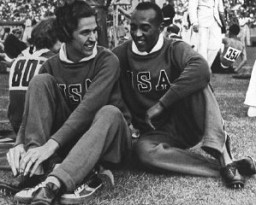
Visiting American newspaper and magazine correspondents view rows of corpses in Dachau. Photograph during an inspection following the liberation of the camp. Dachau, Germany, May 4, 1945.
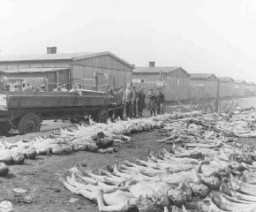
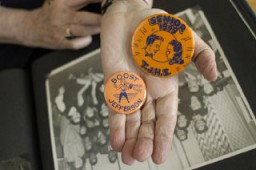
Memorial sculpture in honor of Swedish diplomat Raoul Wallenberg, who helped rescue Jews from the Nazis. Budapest, Hungary, 1990.
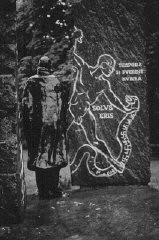
Adolf Berman speaks at a memorial service commemorating the Warsaw ghetto uprising. The building in the background, destroyed during the 1943 uprising, held the office of the Jewish council. Warsaw, Poland, 1945. During the German occupation, Berman was active in the Jewish underground and played a leadership role in the Council for Aid to Jews, known as Zegota.
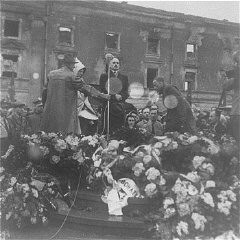
A sign at the military cemetery in Gardelegen in memory of the prisoners who were killed by the SS in a barn near the town. Germany, April 18, 1945.
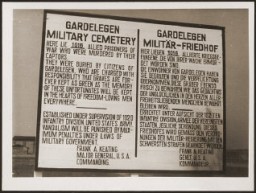
Memorial to Raoul Wallenberg, Swedish diplomat who rescued Jews in Budapest by issuing protective passes. Budapest, Hungary.
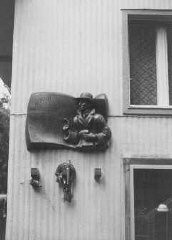
Men in the Ziegenhain displaced persons (DP) camp demonstrate on behalf of free immigration to Palestine, circa 1945 1948. Their banner expresses their wish to go to Israel.

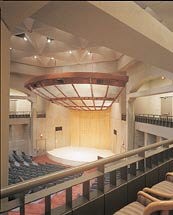
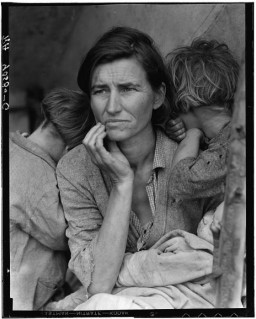
African Americans were among the liberators of the Buchenwald concentration camp. William Scott, seen here during training, was a military photographer and helped document Nazi crimes in the camp. Alabama, United States, March 1943.
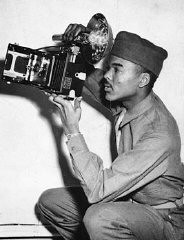
Troops take the oath of obedience to Adolf Hitler. Germany, January 1939.
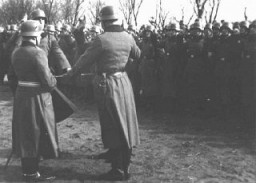
We would like to thank Crown Family Philanthropies, Abe and Ida Cooper Foundation, the Claims Conference, EVZ, and BMF for supporting the ongoing work to create content and resources for the Holocaust Encyclopedia. View the list of donor acknowledgement.